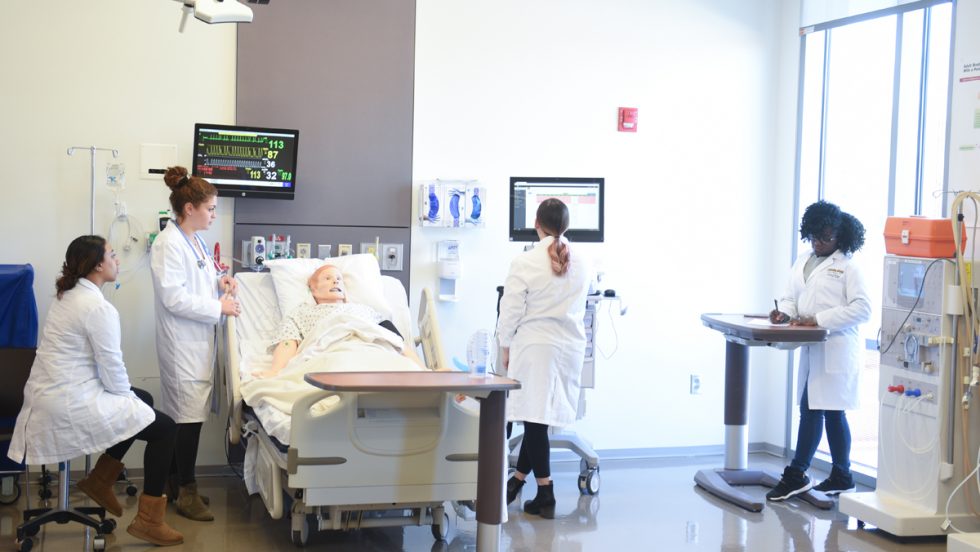
Adelphi's simulation labs provide settings for future nurses to practice their skills.
Nurses were hailed as healthcare heroes during the COVID-19 pandemic and have been voted one of the most trusted professions. However, high turnover, job burnout and other factors have resulted in a nursing staffing shortage that has been exacerbated by the pandemic. Nursing has reached a crisis point, with more nurses leaving the profession than entering.
Meanwhile, for health and safety reasons, it has become increasingly difficult to offer nursing students the required number of clinical hours and clinical training at healthcare facilities. But such training is vitally necessary for prelicensure students to complete their programs and meet eligibility requirements for the NCLEX (National Council Licensure Examination), the standardized examination that individuals must pass in order to obtain licensure as a registered nurse (RN) or licensed practical nurse (LPN) in the United States and Canada.
This is why Deborah Hunt, PhD ’12, dean of the College of Nursing and Public Health, advocated for a policy change as a member of the New York State State Council of Deans and the Nassau-Suffolk Hospital Council Executive Committee. And come November, a New York state law will allow students in nursing schools to complete up to one-third of their clinical training through simulated education.
Dr. Hunt said Adelphi University, with its state-of-the-art Clinical Education and Simulation Lab (CESiL), is well-positioned to help fill a void in nursing education created by the reduction of clinical hours at state-run healthcare facilities.
Although the situation has improved, there are still challenges, particularly in our specialty areas. “But students still need to learn those skills. In our sim lab, they can practice autonomously and be exposed to various scenarios that nurses encounter and learn how to manage them.” Furthermore, simulation provides a different learning experience for students and allows faculty members to tailor the clinical experience in a way that is not always feasible in the clinical setting.
CESiL Looks Like a Hospital on Campus
Located in the Nexus Building, CESiL includes 22 beds, a community health room set up as a one-bedroom apartment, clinical exam rooms, classrooms and high-fidelity manikins that react physiologically as if they were alive.
“We know that students need to be with live patients and healthcare professionals in healthcare settings, but in the sim lab we can control the teaching process,” Dr. Hunt said.
“For example, students need to see a birth and a postpartum hemorrhage. You could be in a healthcare facility for a year and not see that. In the sim lab, they can see it. We also simulate the conversations that should take place between nurses and patients. Our students love the sim lab because they can practice in a safe environment. If they make a mistake, they won’t harm a patient.”
More Nurses Are Needed Now
Locally and nationally, there is a dire need for more nurses:
- According to a 2019 report by the American Journal of Medical Quality, New York is expected to need 39,000 more registered nurses by 2030.
- Almost 33 percent of new nurses in America quit hospital jobs within the first year, says a March 2023 study by NSI Nursing Solutions, a Pennsylvania-based recruiting firm.
- The average age of a registered nurse in the United States is 52, according to a 2020 study by the American Association of Colleges of Nursing.
“Many of the current nursing workforce are nearing retirement age; more nurses are leaving because they feel overwhelmed and not enough nurses are coming in,” Dr. Hunt said. “We were having difficulty securing pediatric clinical experiences for our students , so we submitted a request to the state if we could use days in the sim lab for pediatric and obstetrics training, and the state approved that.”
Adelphi’s CESiL has high-fidelity adult, birthing mother, newborn, infant and child manikins in addition to medium-fidelity manikins. It is also piloting virtual reality tools to simulate nurse-patient interactions.
“You put your goggles on and you’re immediately immersed into a patient’s room,” Dean Hunt said. “The avatar of the patient talks to you or grimaces. You pick up a stethoscope and listen to heart sounds. You give medication. It doesn’t replace clinical training, but it’s another supplemental learning tool.”
And the virtual technology available to Adelphi nursing students will only get better, according to Anthony Egan, director of the CESiL.
“As artificial intelligence becomes more advanced, the responses that an avatar can give our students will improve,” he said. “When the avatar learns more medical terms, common language and slang terms, the students will learn more during each of those interactions.”
Adelphi Seeks a First-in-State Credential
With such unique learning experiences to offer, Adelphi is seeking to become the first university in the state to earn accreditation from the Society for Simulation in Healthcare.
“Some may fear that simulated training will take the place of the in-person human experience, but it won’t,” Dr. Hunt said. “ We are well aware of the importance of all students having direct patient care experiences. However, the simulation is well planned and the debriefing session is the most important part of any simulated session and where the most learning occurs. After your training, whether it’s in a sim lab or virtual, you meet with your instructor and talk about your assessments, your interventions, what you did right, what you did wrong, what you can improve on.”